An Easy Aioli Recipe For Creamy, Garlicky Dipping & Spreading!
Craving some aioli but can’t get to the store or restaurant? Don’t worry – homemade aioli is easy to make!
Similar to how we make homemade mayonnaise, this aioli recipe is made with an egg yolk, olive oil, and garlic for that classic Mediterranean flavor.
This aioli recipe is dangerously good with sweet potato fries but has lots of other uses, too!
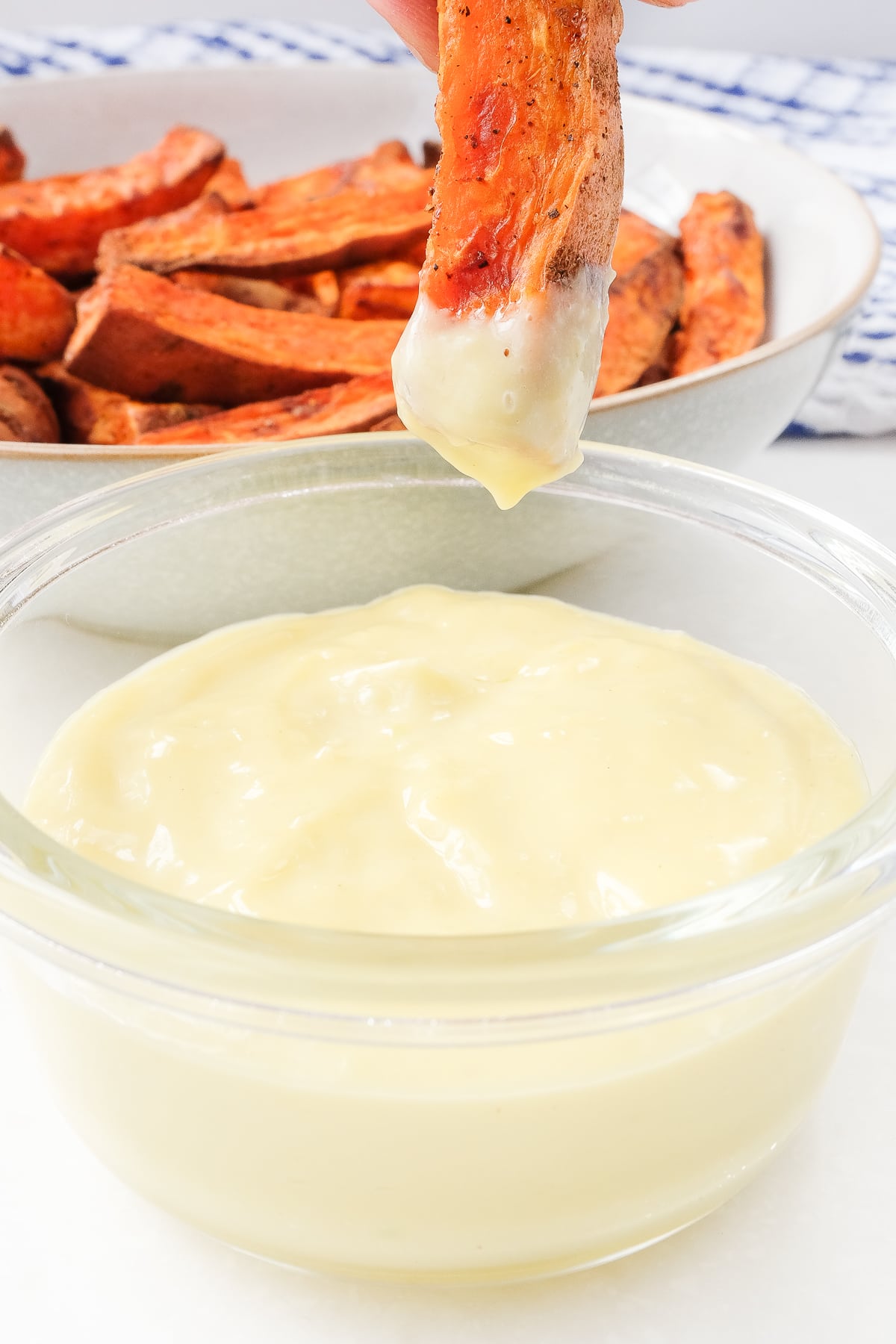
Different Versions of Aioli
Aioli was commonly eaten in the regions around the Mediterranean Sea – this includes parts of France and Spain. However, nowadays it is also popular in many other parts of the world.
As you can imagine, there are quite a few different ways to make it:
- The sauce is called aioli in France where it is usually made with egg yolk, lemon juice, and sometimes mustard.
- It is called Alioli in most of Spain and also typically contains egg.
- The Catalan version is called Allioli and is commonly only made with garlic, salt, and olive oil.
So, generally, you can play around with the ingredients quite a bit and see which texture and flavor you prefer. The recipe we share below is just one way to make aioli.
In North America, a term people sometimes use to describe this sauce is “garlic aioli”. Technically, this doesn’t really make sense because aioli, by definition, is made with garlic. That would be like saying that you’re making “tomato-based tomato sauce”.
The reasoning behind this term is likely that, over the last few decades, people in North America (not so much in Europe) have started calling mayonnaise that is flavored with something else (garlic, herbs, lemon, red pepper, etc.) “aioli”.
A good example here is “garlic mayo”. Garlic mayo is, again by definition, basically just aioli and not really “garlic aioli”. But in the same way we’d say “Siracha Mayo” or “Tomato/Basil Mayo”, the term “garlic aioli” became commonly used to differentiate “traditional aioli” from other aioli flavor variations that might exist (even if it’s redundant).
Recipe Tips/Substitutions
Before you dive into making this creamy aioli sauce, read up on these recipe tips so that you achieve best results:
- Make sure to only use very fresh eggs when making this recipe.
- We would recommend either using light olive oil or half extra virgin olive oil and half avocado oil (or another neutral-tasting oil). If you only use (extra) virgin olive oil, the flavor can be quite overpowering and easily too much, especially if you are not used to it.
- Aioli is an emulsion – meaning you’re mixing fat with something it doesn’t want to mix with. So, you have to add the oil in slowly or else the mixture might “break” and fail to become creamy and consistent.
- Making aioli works really well with an immersion blender. However, you can also use a whisk to make this aioli by hand and it works just fine (just takes a bit longer).
- As mentioned above, there are a few different versions for aioli/alioli/allioli so feel free to play around with the ingredients a bit. You can add mustard or not, skip the lemon juice or egg yolk if you so choose, and/or add more garlic if you prefer. However, if you have never made aioli before, we would recommend following our recipe below the first time so you can get a feel for how the emulsion works and what the consistency ends up being.
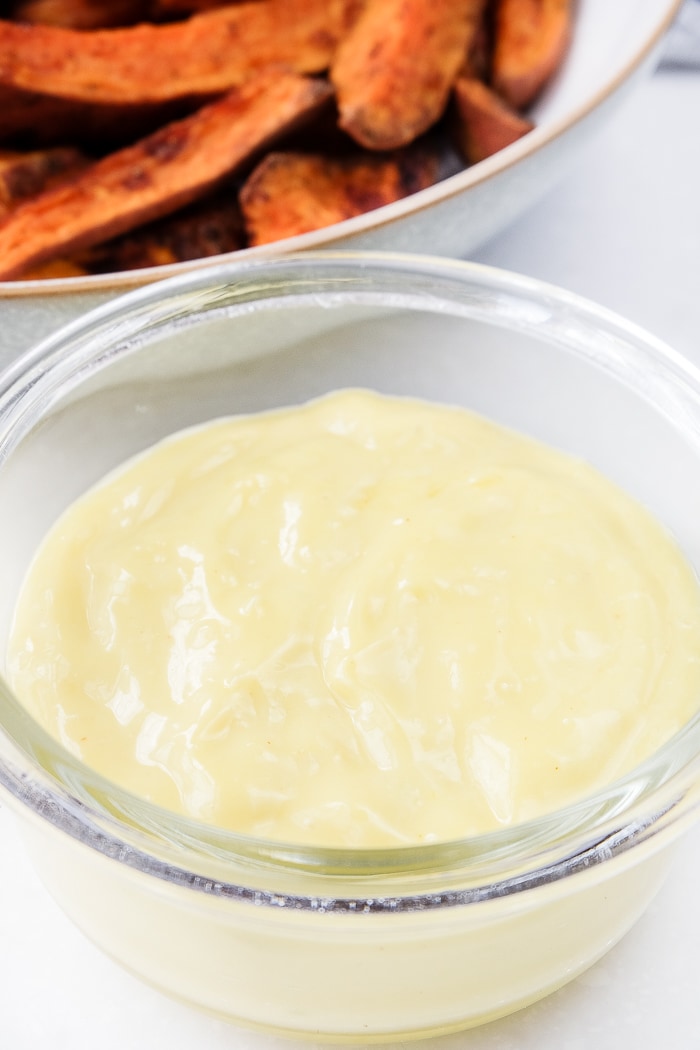
How to Make Aioli – Step by Step Instructions
For those just wanting to make aioli, you can find the detailed aioli recipe card at the bottom of this post.
If you want to see the visual step-by-step instructions for how to make aioli from scratch, have a look at this section.
This way, if you have any questions you can check out exactly how we made ours!
Remember: We use a whisk to show how it works since not everyone might have an immersion blender, but it works really well with an immersion blender (and it’ll be much faster, too).
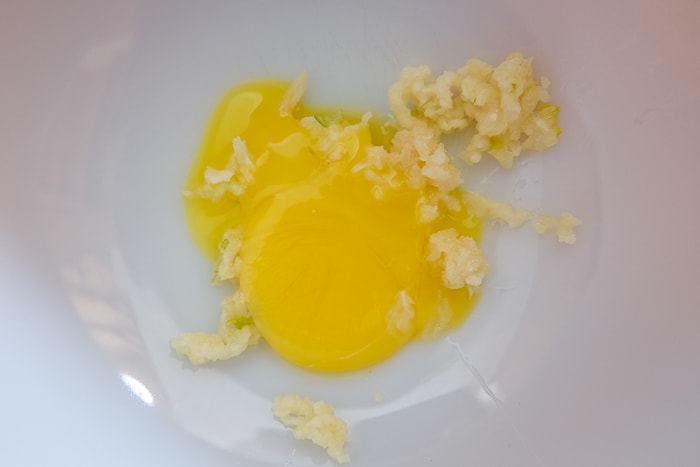
First, separate the egg and put the egg yolk into a mixing bowl or the container for your immersion blender. Keep the egg whites – you can use them in another recipe!
Peel the garlic cloves and crush or mince them. Then add them to the bowl as well.
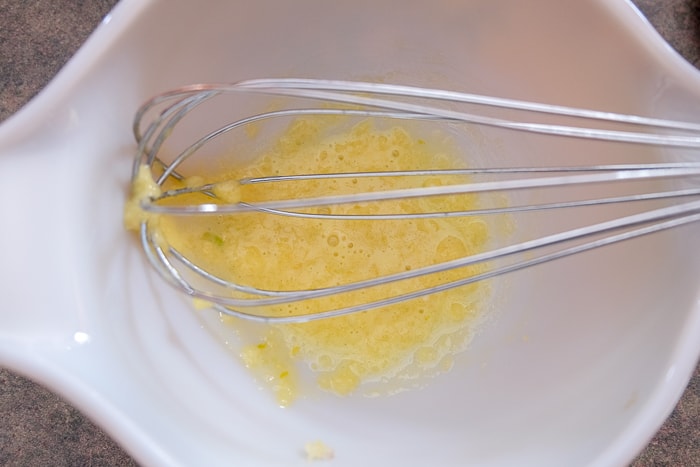
Next, add the lemon juice, salt, (and mustard, if you want to) to the bowl as well.
Briefly whisk the contents of the bowl until sufficiently mixed and uniform in color. You can also use an immersion blender if you have one.
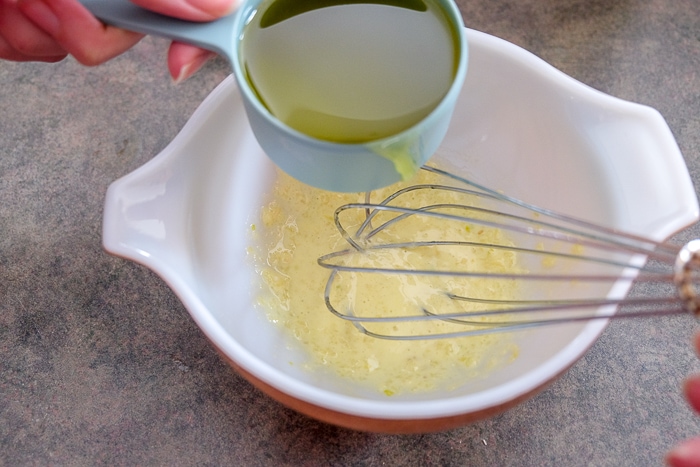
Now, slowly pour in the oil slowly while whisking or blending constantly.
Add the oil in a little bit at a time – this ensures that the aioli achieves a creamy consistency instead of “breaking” (where the oil and other ingredients repel each other).
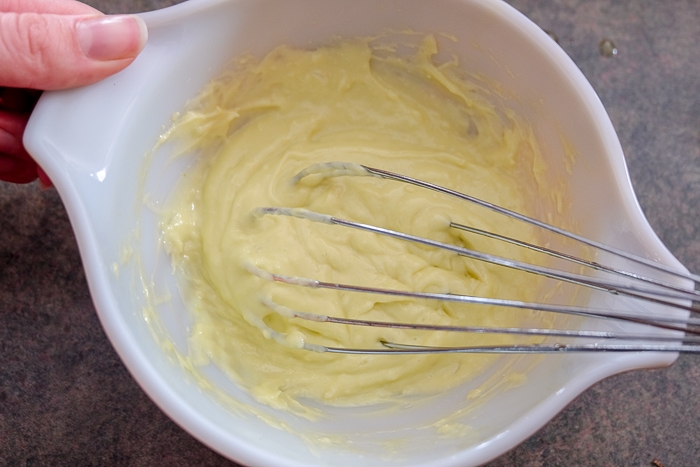
Keep whisking/blending until all the oil has been added and the aioli has achieved a creamy consistency.
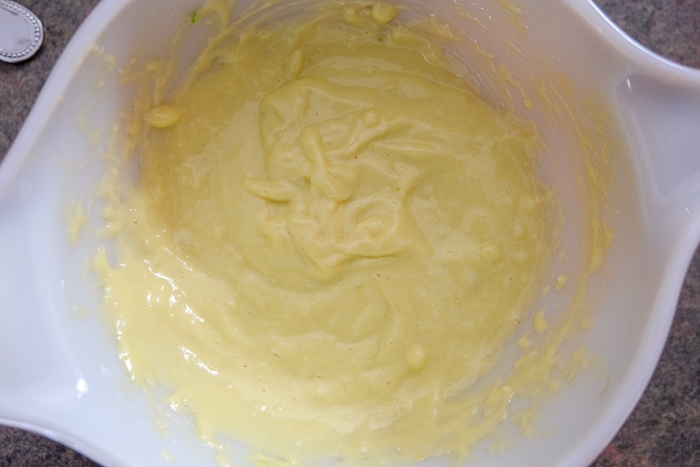
Give it a taste and add more salt if desired.
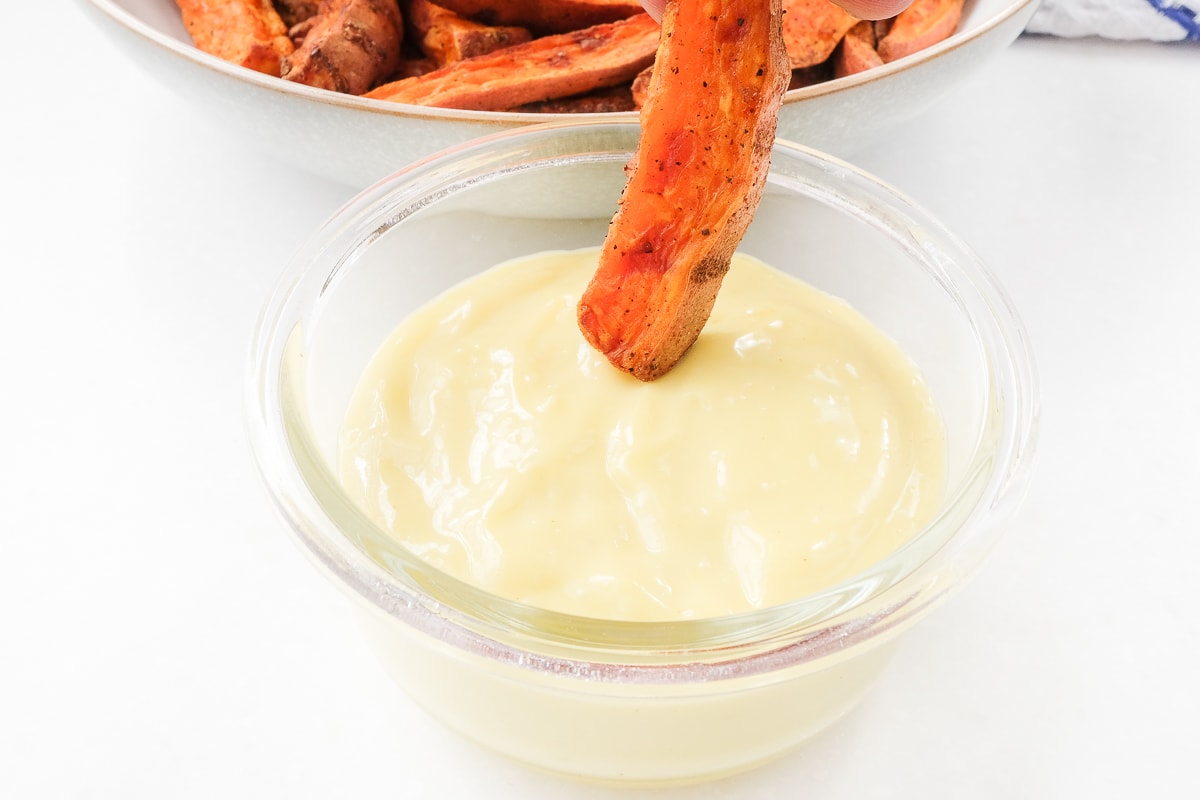
Store the homemade aioli in a sealed container with a lid in the fridge until you’re ready to spread it or dip it!
Storage Tips
Since this aioli contains raw egg, it’s important to keep it in a sealed container in the fridge. Homemade aioli doesn’t have as many preservatives as store-bought so you’ll need to eat it within 3-4 days (the sooner the better).
If the aioli ever looks or smells “off”, discard it right away and definitely don’t eat it.
FAQ
Aioli is a Mediterranean emulsion mixture – similar to mayo – that is traditionally made from garlic, salt, and olive oil.
The difference between aioli and mayonnaise is mainly in the flavors. Both are emulsions (when ingredients – usually a fat and a liquid – mix even though they are chemically not really supposed to). Aioli is made with garlic and olive oil whereas basic mayo is made without garlic and typically not with olive oil (often it’s made from canola or vegetable oil).
Related Recipes
For more great recipes that involve something creamy, check out these tasty ideas:
- Homemade Mayonnaise – A simple recipe for yummy homemade mayo
- Romesco Sauce – A Spanish dipping sauce!
- Patatas Bravas – Fried Spanish potatoes with a smoky, spicy bravas sauce!
- Vanilla Sauce – A recipe for a sweet and versatile vanilla sauce from scratch
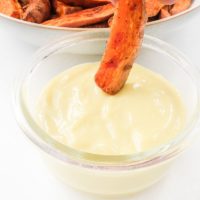
Homemade Aioli
Ingredients
- 1 egg yolk from large egg
- 3 medium-sized garlic cloves, crushed or minced
- 2 teaspoons lemon juice
- 1/4 teaspoon salt, more or less to taste
- 1/2 teaspoon Dijon mustard, optional
- 1/2 cup light olive oil, or 1/4 cup extra virgin olive oil + 1/4 cup avocado oil
Instructions
- Separate the egg and put the egg yolk into a mixing bowl or the container for your immersion blender. Keep the egg whites – you can use them in another recipe!
- Peel the garlic cloves and crush or mince them. Then add them to the bowl.
- Next, add the lemon juice, salt, (and mustard, if you want to) to the bowl as well.
- Briefly whisk the contents of the bowl until sufficiently mixed and uniform in color. You can also use an immersion blender if you have one.
- Now, slowly pour in the oil slowly while whisking or blending constantly. Add the oil in a little bit at a time – this ensures that the aioli achieves a creamy consistency instead of "breaking" (where the oil and other ingredients repel each other).
- Keep whisking/blending until all the oil has been added and the aioli has achieved a creamy consistency. Give it a taste and add more salt if desired.
- Store the homemade aioli in a sealed container with a lid in the fridge until you’re ready to spread it or dip it!
Notes
- We like adding Dijon mustard to our aioli but this is not really "traditional".
- We would recommend either using light olive oil or half extra virgin olive oil and half avocado oil (or another neutral-tasting oil). If you only use (extra) virgin olive oil, the flavor can be quite overpowering and easily too much, especially if you are not used to it.
- As mentioned, a whisk works well for stirring but an immersion blender also works wonders for this kind of recipe. You can also use the "whisk" attachments for an electric mixer if your mixer comes with one. We wouldn’t recommend using a normal blender because it can get messy and it’s harder to control the whisking and adding of the oil (at least with our blender it is).
Nutrition
This nutritional information has been estimated by an online nutrition calculator. It should only be seen as a rough calculation and not a replacement for professional dietary advice.
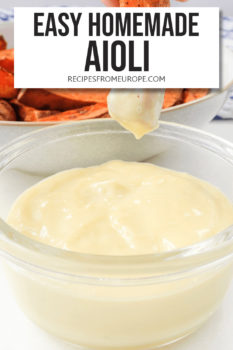

The original term in catalan is “all i oli ”
This is “garlic with oil ”
Along time this is know as “allioli” in Catalogne
Now several names around the world refers the same recipe.